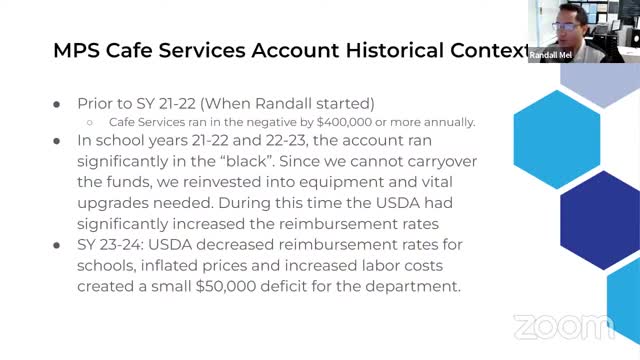School nutrition program battles funding cuts and rising costs
September 09, 2024 | Middletown School District, School Districts, Connecticut
This article was created by AI summarizing key points discussed. AI makes mistakes, so for full details and context, please refer to the video of the full meeting. Please report any errors so we can fix them. Report an error »

In a recent government meeting, officials discussed the financial challenges faced by school nutrition programs, particularly in the wake of fluctuating reimbursement rates from the USDA. The meeting highlighted the significant impact of a decrease in these rates, which has forced districts nationwide to grapple with substantial revenue losses. One local district reported a deficit of $50,000, which was covered by the local board of education budget.
The discussion emphasized the importance of effective fund allocation, with annual costs for labor and food reaching approximately $1.5 million and $1.3 million, respectively. Additional expenses include $150,000 for paper goods and various compliance-related costs. Officials noted that maintaining quality meal service while managing these expenses is a top priority.
To mitigate costs, the district has implemented strategies such as daily monitoring of meal participation and monthly assessments of labor efficiency. By comparing the number of meals served to labor hours, adjustments can be made to optimize staffing levels. The district operates with a lean management team, consisting of just two individuals, which allows for more funds to be directed toward meal programs rather than administrative costs.
Budget constraints have led to strict food cost limits, with elementary schools capped at $2,000 per week and secondary schools at $6,000. This approach not only helps control expenses but also encourages creative use of leftovers to reduce food waste. The district is also focused on marketing its meal offerings to students and parents, aiming to shift perceptions about school meals and highlight improvements in quality and sourcing, including a commitment to local farms when feasible.
Overall, the meeting underscored the ongoing challenges and innovative strategies employed by school nutrition programs to ensure that students receive nutritious meals while navigating financial constraints.
The discussion emphasized the importance of effective fund allocation, with annual costs for labor and food reaching approximately $1.5 million and $1.3 million, respectively. Additional expenses include $150,000 for paper goods and various compliance-related costs. Officials noted that maintaining quality meal service while managing these expenses is a top priority.
To mitigate costs, the district has implemented strategies such as daily monitoring of meal participation and monthly assessments of labor efficiency. By comparing the number of meals served to labor hours, adjustments can be made to optimize staffing levels. The district operates with a lean management team, consisting of just two individuals, which allows for more funds to be directed toward meal programs rather than administrative costs.
Budget constraints have led to strict food cost limits, with elementary schools capped at $2,000 per week and secondary schools at $6,000. This approach not only helps control expenses but also encourages creative use of leftovers to reduce food waste. The district is also focused on marketing its meal offerings to students and parents, aiming to shift perceptions about school meals and highlight improvements in quality and sourcing, including a commitment to local farms when feasible.
Overall, the meeting underscored the ongoing challenges and innovative strategies employed by school nutrition programs to ensure that students receive nutritious meals while navigating financial constraints.
View full meeting
This article is based on a recent meeting—watch the full video and explore the complete transcript for deeper insights into the discussion.
View full meeting
